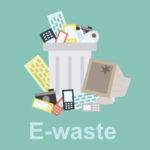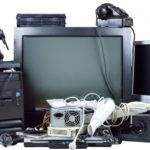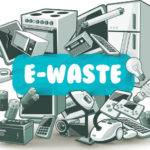1. A Brief History on the Electronic Waste Disposal Industry
 The history of electronic waste disposal generally began in the mid-70s. Since 1976, with the passage of the Resource Conservation and Recovery Act (RCRA), it has been illegal to dump e-waste in the United States. Since the Basel Convention in 1989, it has been likewise illegal to dump e-waste in less developed countries. Since it became illegal to dump e-waste in many areas in the world, a new solution had to be developed in order to properly deal with electronic waste disposal. This has led to the practice of legally and cleanly recycling worn-out electronic equipment.
The history of electronic waste disposal generally began in the mid-70s. Since 1976, with the passage of the Resource Conservation and Recovery Act (RCRA), it has been illegal to dump e-waste in the United States. Since the Basel Convention in 1989, it has been likewise illegal to dump e-waste in less developed countries. Since it became illegal to dump e-waste in many areas in the world, a new solution had to be developed in order to properly deal with electronic waste disposal. This has led to the practice of legally and cleanly recycling worn-out electronic equipment.
Dumping E-Waste in the World’s Oceans Has Led to International Laws
A series of international incidents took place in the 1980s that led directly to the passage of legislation regarding the dumping of e-waste. One of the most publicized incidents involved a Liberian ship called the Khian Sea. This ship was hired to cart away 14,000 tons of incinerated e-waste ash from the city of Philadelphia. The ash was originally bound for New Jersey, but authorities there refused to receive it. As a result, the ship headed southward for the Caribbean, dumping 4,000 tons of ash there. The rest was ultimately dumped at various places as the ship headed for Southeast Asia.
Public outcry over this incident led directly to the above mentioned Basel Convention. As a result of this historic convention, laws regarding the safe disposal of e-waste were adopted. These laws remain binding to this day. This is the main reason that the recycling industry has grown from a mere local hobby to large and lucrative industry.
The Need for Electronic Waste Disposal Has Led to a Whole New Industry
Since the time of the Basel Convention, the need for safe and efficient electronic waste disposal has led to the creation of a whole new industry. This is the recycling industry, which is devoted to taking out reusable parts from discarded electronic equipment items. These reusable parts are then recycled for the benefit of local businesses. This is an entirely new industry that creates jobs for thousands of workers all across the world. The work done by these electronic recycling companies have been instrumental in saving many local environments from serious harm.
Electronic Waste Disposal is an Issue that Affects Millions of People
Proper e-waste disposal is an issue that has consequences far beyond the reach of your local environment. You need to know that old computers, cell phones, monitors, and other bits of electronic equipment all contain ingredients that are toxic to the environment. As a result, when you simply dump them into a landfill or nearby body of water, you are doing a truly heinous thing. How would your customers react if they knew that you were poisoning their local environment with toxic ingredients, such as chromium, radium, and beryllium? The damage done to your reputation could be fatal.
2. Electronic Revolution = E-Waste
 The electronic revolution has changed how we lived, communicated and has brought people around the world closer.
The electronic revolution has changed how we lived, communicated and has brought people around the world closer.
We are in a great era of technological advancement and we are a generation obsessed with technology. We have gadgets of all kinds – from our appliances to our computers and laptops, to our ever-changing cell phones.
We change our gadgets almost as often as we buy new clothes. Every time a new upgrade comes out, we throw our old gadgets away and buy a new one.
Can you imagine how much electronic waste we generate? Where does it all go?
A culture of use and throw-away
E-Waste are electronic devices and gadgets nearing or at the end of its useful life. It covers discarded obsolete electronic devices, cellphones, notebooks, game consoles, and their components.
Here are some electronic waste facts that you will find interesting and alarming:
- We generate around 40 million tons of electronic waste every year, worldwide. That’s like throwing 800 laptops every second.
- An average cellphone user replaces their unit once every 18 months.
- E-waste comprises 70% of our overall toxic waste.
- Only 12.5% of E-Waste is recycled.
- 85% of our E-Waste are sent to landfills and incinerators are mostly burned, and release harmful toxins in the air!
- Electronics contain lead which can damage our central nervous system and kidneys.
- A child’s mental development can be affected by low-level exposure to lead.
- The most common hazardous electronic items include LCD desktop monitors, LCD televisions, Plasma Televisions, TVs and computers with Cathode Ray Tubes.
- E-waste contains hundreds of substances, of which many are toxic. This includes mercury, lead, arsenic, cadmium, selenium, chromium, and flame retardants.
- 80% of E-Waste in the US and most of the other countries are transported to Asia.
- 300 million computers and 1 billion cellphones go into production annually. It is expected to grow by 8% per year.
Is E-Waste Bad?
Many of our E-Waste end up in Asia or Africa landfills. The recycling method in these landfills is not the “recycling” that we have in mind. E-Waste is bad, for you and me, for our planet and most especially for the workers on the landfills.
E-Wastes are buried or incinerated in landfills where their toxins pollute our land, air, and water. Most of the time, they are sent to developing countries where workers extract precious metals from discarded electronics.
Workers on E-Waste sites are paid an average of $1.50 per day. They are unprotected while working with the toxic substances on the site. They are the first to inhale the toxins that are released in the air when electronic parts are burned. Many of these workers are children!
Why we should recycle Electronics
- Cellphones and other electronic devices contain precious metals like gold and silver. The US alone throws away cellphones with $60 million worth of gold/silver yearly.
- Recycling 1 million laptops saves energy equivalent to the energy used by 3600 homes in the US annually.
- Most of the components of E-Waste are electronic equipments that can be re-used and recycled for materials recovery.
What can we do about our personal E-Waste
There are several options when it comes to the proper disposal of your electronic devices.
- Your old cellphone can still be used by another person. Same with your old computer or television. Donate it to friends, charities or community outreach programs – even to a stranger! This is better than the hazardous e-waste materials ending up in a landfill somewhere. At the same time, you make someone happy. It’s a win-win option!
- Find a Certified E-Waste Recycler. Those who are not certified will just send it off somewhere else where it can do its damage.
Be part of the solution and help reduce our electronic waste.
We cannot stop you from changing your devices as often as you want but discard your old ones properly. When it comes to E-Waste, there is probably another person in the world who can benefit from your unwanted devices. Find them before you throw it away. Let’s keep our electronic waste as far away from landfills as possible.
Article source: theworldcounts.com
3. Facts About E-Waste
 There are some things you never know about E-Waste. And here are the 11 Facts about E-Waste:
There are some things you never know about E-Waste. And here are the 11 Facts about E-Waste:
- In 2009, discarded TVs, computers, peripherals (including printers, scanners, fax machines) mice, keyboards, and cell phones totaled about 2.37 million short tons
- E-waste represents 2% of America’s trash in landfills, but it equals 70% of overall toxic waste
- 20 to 50 million metric tons of e-waste are disposed worldwide every year
- Cell phones and other electronic items contain high amounts of precious metals like gold or silver. Americans dump phones containing over $60 million in gold/silver every year
- A large number of what is labeled as “e-waste” is actually not waste at all, but rather whole electronic equipment or parts that are readily marketable for reuse or can be recycled for materials recovery
- Only 12.5% of e-waste is currently recycled
- For every 1 million cell phones that are recycled, 35,274 lbs of copper, 772 lbs of silver, 75 lbs of gold, and 33 lbs of palladium can be recovered
- Recycling 1 million laptops saves the energy equivalent to the electricity used by 3,657 U.S. homes in a year
- E-waste is still the fastest growing municipal waste stream in America, according to the EPA
- It takes 530 lbs of fossil fuel, 48 lbs of chemicals, and 1.5 tons of water to manufacture one computer and monitor
- Electronic items that are considered to be hazardous include, but are not limited to: Televisions and computer monitors that contain cathode ray tubes, LCD desktop monitors, LCD televisions, Plasma televisions, Portable DVD players with LCD screens
Article source: dosomething.org


